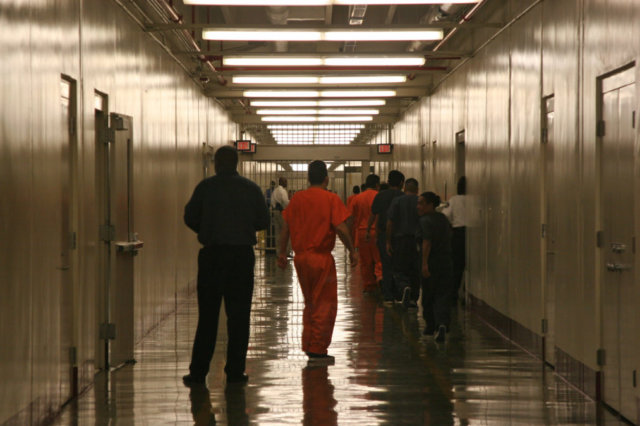
By Patrick Michels
Reveal from The Center for Investigative Reporting
Surprise inspections at six immigrant detention facilities revealed that U.S. Immigration and Customs Enforcement is subjecting people in its custody to a host of dangerous and harmful conditions that violate its own rules, according to a new report.
The inspectors made unannounced visits to six detention centers, in response to complaints from immigrant rights advocates and people being held in the facilities. The problems they found, inspectors wrote, “undermine the protection of detainees’ rights, their humane treatment, and the provision of a safe and healthy environment.”
The report was released Thursday by the Department of Homeland Security Office of Inspector General and documented the following problems:
- Dangerous detainees were housed with people classified as low-risk.
- Detainees were subjected to mandatory, universal strip-searches.
- Detainees were not treated “respectfully and professionally.”
- Detainees weren’t given access to translation during booking and medical visits.
- Staff threatened detainees who tried to file formal grievances.
- Some facilities “may have” improperly placed detainees in solitary confinement.
- Detainees faced long waits for medical care.
ICE detention is a civil, not criminal, arrangement, but ICE either contracts with county jails or private prison operators to hold its detainees. Under President Barack Obama, ICE began designing a new detention model that would grant more freedom to people in custody. But that initiative is apparently on hold, and the Trump administration said earlier this year it would close the office handling that project.
Three sets of standards guide detainee care across the ICE detention network, depending on when the facility first contracted with ICE. President Trump has considered rolling back those standards to a brief checklist, but has apparently shelved that proposal for now.
According to the report, inspectors chose to visit six facilities that were “of particular concern” based on complaints their office received:
- Hudson County Jail in Kearny, N.J., operated by Hudson County
- Laredo Processing Center in Texas, operated by CoreCivic
- Otero County Processing Center in Chaparral, N.M., operated by Management & Training Corporation
- Santa Ana City Jail in California, operated by the City of Santa Ana; ICE
- Stewart Detention Center in Lumpkin, Georgia, operated by CoreCivic
- Theo Lacy Facility in Orange, Calif., operated by the Orange County Sheriff’s Department
Inspectors gave high marks to the Laredo facility, writing that it “modeled quality operations” during their visit. But every other facility on the list fell short of ICE standards.
The Theo Lacy Facility, one of two Orange County jails in which ICE holds people, was the subject of a scathing OIG report in March. That review found spoiled meat being served to detainees, moldy showers and broken telephones.
The report released this week documents similar concerns at other facilities, including a poorly managed grievance process at the Stewart Detention Center and broken phones at the Otero County Processing Center.
“At the Santa Ana City Jail,” inspectors wrote, “staff confirmed detainee reports of personnel strip-searching all detainees upon admission.”
According to ICE standards, people in ICE custody should only be strip-searched when they’re suspected of having contraband. The practice was particularly troubling at Santa Ana because ICE had designated that jail as its first dedicated unit for gay, bisexual and transgender people, to limit their risk of sexual assault in detention.
Advocacy groups’ complaints about strip-searches, in part, prompted the Santa Ana City Council to scale back its contract with ICE last year, after which ICE did away with the contract entirely.
After the OIG found violations at the nearby Theo Lacy Facility, however, ICE rewarded its operator, the Orange County Sheriff’s Department, with an expanded contract worth another $5 million a year. ICE said it was satisfied that the department had corrected its practices after the inspectors’ visit.
In response to the inspectors’ findings, ICE said it would direct its field offices to keep an eye out for further violations like the ones OIG found. The agency did not mention plans to punish facilities for violating its standards.
Along with investigating complaints into DHS employees, the OIG investigates waste, fraud and abuse within the department. In the past year, the office has also released studies that were critical of the agency’s ability to secure the border and to recruit and screen new Border Patrol agents. Trump proposed cutting OIG’s funding by 10 percent in his budget request before lawmakers restored the funding.






















